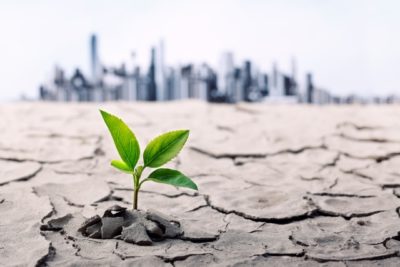admin | 02/10/2018
“Climate change can be considered in itself a new risk, due to the abrupt change in environmental conditions it is causing, which will only increase in the coming decades.
This and the minimization of associated risks are the main themes of the conversation we had with one of the most renowned climatologists, Javier Martín-Vide.
Insurance and Risk Management:What is the current situation of global warming?What are its main causes?
Javier M Global warming is unequivocal.We can say with certainty that we live on a warmer planet and in a warmer country than 30 years ago. Between 1880-2012, the annual average surface air temperature has increased 0.85ºC (according to the IPCC Fifth Assessment Report), which seems little but represents a significant increase at the global level. In the specific case of Peninsular Spain and the Balearic Islands, the heat increase is nearly 1ºC. The main cause of global warming is the increase in the concentration of greenhouse gases, in particular, CO2.
What are the main risks that human beings face from climate change?Which ones are particularly worrisome in underdeveloped areas?
Climate change can be considered in itself a new risk, due to the abrupt change in environmental conditions it is causing, which will only increase in the coming decades. Among the risks its entails are heat waves (more frequent and intense), which increase mortality; rainfall extremes (long droughts in subtropical and tropical areas); heavy precipitation, with floods in mid to high latitudes; and the rise in sea level, severe in coastal areas, where a considerable percentage of the world population lives. In poor tropical countries, droughts and the rise in sea level along the coast are particularly troubling.
What are the key actions for minimizing these risks?
From my point of view, the key lies in decreasing the vulnerability of the population and reducing the exposure of the land itself, because risks or, better yet, natural hazards, will most likely occur with greater frequency and intensity. Decreasing vulnerability is a complex task that requires numerous actions, from environmental education to civil protection organization services to construction of safe and well-balanced infrastructures. To reduce the exposure to risks, adequate land planning is important, as is the use of early warning and detection systems. Early warning has a lot to do with prevention. To make an analogy with health, heading off any risk allows us to confront the risk with more possibilities of overcoming it or reducing undesired effects. In any case, prevention is better than cure.
“Most big companies know that climate change could affect turnover and even the survival of their own activity.Their transformation into companies that advocate for sustainability and the environment is an increasingly pressing need.”
The effects of climate change are visible in the economy as a whole. How does climate change impact the Spanish and Latin American economy?Which sectors are most affected by the climate imbalance.
In short, climate change has direct and indirect implications in practically every economic sector, although agriculture is always mentioned as the most vulnerable. I think that the effect of climate change on the energy sector is even greater. In my opinion, we have no other option but to change the energy model urgently, placing emphasis on renewable, clean energies. This can’t be done overnight. Still, the so-called energy transition to the new model, divested of coal, and with energy efficiency as a guiding principle, needs to gain steady speed, under the threat that global warming will exceed the known 2ºC compared to the preindustrial period, which would entail irreversible consequences for the planet. This was the primary alert sounded in the Paris Agreement of December 2015.The energy sector is also crucial to the Spanish and Latin American economies.

Within the insurance landscape, parametric insurance is tied to climate factors, such as temperature change, wind or lack of sun. Do you think the role of climate analysis will become increasingly larger? Do you notice any basic trend in parametric insurance?
I think that parametric insurance will increase its presence in the new climate context. Apart from the management savings it entails and the absence of expert damage reports, this is because of the vast amount of meteorological data available, accurate knowledge of the correlation between climate variables and affect threshold, and the increasingly limited margin of uncertainty of climate projections. Every insurance company knows that climate variables drivers of their business – are essential to the forecasting and coverage of risks.And they will be even more so for two reasons:the more than likely increase in climate risks and the importance in the new model of renewable energy sources, many of them based precisely on climate variables (sunshine, wind speed).

Do you think there is a lack of knowledge of the risk of climate change in companies and society?
In some cases, yes. Risk perception studies give us an idea of the mental images that citizens, companies and government have. It isn’t strange that, in general, risks are underestimated. This leads to the increase in the risk itself as a function not only of natural hazard but also the vulnerability of society and the exposure of the land. If risks are underestimated, decisive action will have to be taken to provide clearer and more direct information about these risks to all sectors of society, indicating the most adequate behavior guidelines for facing them. We need to remember that human behavior does not reflect reality per se but how we perceive it.
Weather events, some caused by existing climate change, affect the human capital, assets and business activity of many companies. What role do private companies play in climate change research and the fight to mitigate the risks climate change entails? Is there cooperation between the private and public sector, from this perspective?
Most big companies know that climate change could seriously effect turnover and even the survival of their own activity. Their transformation into companies that advocate for sustainability and the environment is no longer embraced because it is considered fashionable. It is not simply a veneer of modernity. Rather, it is an increasingly pressing need. Insurance and reinsurance companies in particular, are immersed in this problem. Many of them have reliable technical teams that engage in applied research regarding the foreseeable evolution of natural risks, including climate-related risks, or support research through publications and aid in this field. So-called industrial doctorates encourage applied research and integration of researchers in the private sector. Still, in the case of Spain, more permeability and trust is needed between the public sector and private business.
Both in Spain and Latin America, climate models coincide in depicting warmer countries.
What does land management involve? How can it help to reduce natural risks?
Land management is an inherently geographical activity in which the land is considered an essential, non-renewable, limited and fragile asset with natural, cultural and heritage value that cannot be reduced to the mere price of the land. This characterization of the land appears in “Manifiesto por una nueva cultura del territorio’” (Manifesto for a new land culture), which a group of geographers and other scholars promoted over a decade ago. Land planning needs to establish technical and consensual agreements regarding human settlements, spaces to protect and road infrastructures, in terms of their development and location. All of this will contribute to reducing natural and technological risks.
What possible scenarios are managed?
Climate models, which are the most effective tool we have for studying climate change, provide us with climate projections. These point to a gradually warmer planet, between 1ºC and 3.7ºC warmer by the end of the century.The increase will be greater or smaller depending on how we act, because human beings and our socioeconomic system constitute what I like to call the sixth component of the climate system (traditionally made up of five natural components: atmosphere, hydrosphere, lithosphere, biosphere and cryosphere).
“Adapting to the new scenarios will allow for reducing risks and, in some cases, taking advantage of new opportunities.”
In your opinion, what are the most noteworthy weather events we can expect for the rest of the year and for 2019?
There’s no way to know. Weather is volatile and fleeting; beyond a few days, it’s essentially unpredictable. Still, from a climate point of view, we can expect new high temperature records in many regions of the world.
What does the future climate map in Spain and Latin America look like? Should companies be preparing to respond to it?
Both in Spain and Latin America, climate models coincide in depicting warmer countries, and probably drier ones in tropical and subtropical regions. All social agents. All economic sectors. The man or woman in the street and the government must be equipped to deal with climate change under the best possible conditions . Adapting to the new scenarios will allow for reducing risks and, in some cases, taking advantage of new opportunities.Also, forward-thinking insurance companies must adjust their business model to the coming challenges in a globalized, accelerated and more unpredictable world than a few decades ago.
Javier Martín-Vide
Climate change expert

Martín-Vide (Barcelona, 1954) is a professor of Physical Geography at Universidad de Barcelona, a climate expert, a member of the Barcelona Royal Academy of Arts and Sciences, and a member of the Académie Royale des Sciences d’Outre-Mer (Belgium) and the Malaga Academy of Sciences, among other honors on his extensive resume.He is also the author of 25 books and three hundred publications, including articles and book chapters.
“When I was a little boy, barely 10 years old, I liked to observe the rain and other weather phenomena. Not much later, I began keeping a diary, where I recorded the weather (sky conditions, meteors).Later, with a clear objective, I studied science, mathematics, geography and history. In the last of these areas, there were courses in climatology, in addition to others about the physical environment. With the help of math and a geographic focus, I developed my doctoral thesis, a probabilistic analysis of precipitation in Mediterranean coastal areas of the Iberian Peninsula.
Also, as a geographer, travel is one of my most cherished hobbies. I also do some sports, mainly hiking and fun runs, and a few years ago, indoor soccer. I like poetry very much, with some unpublished attempts. I also enjoy music, from Bach to the Electric Light Orchestra to the Eagles to Raphael.”





